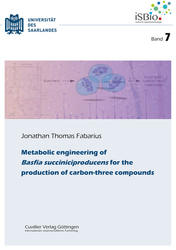| Fachbereiche | |
|---|---|
| Buchreihen (96) |
1378
|
| Nachhaltigkeit |
3
|
| Gesundheitswesen |
1
|
| Geisteswissenschaften |
2364
|
| Naturwissenschaften |
5406
|
| Mathematik | 229 |
| Informatik | 319 |
| Physik | 980 |
| Chemie | 1363 |
| Geowissenschaften | 131 |
| Humanmedizin | 243 |
| Zahn-, Mund- und Kieferheilkunde | 10 |
| Veterinärmedizin | 108 |
| Pharmazie | 147 |
| Biologie | 835 |
| Biochemie, Molekularbiologie, Gentechnologie | 121 |
| Biophysik | 25 |
| Ernährungs- und Haushaltswissenschaften | 45 |
| Land- und Agrarwissenschaften | 1004 |
| Forstwissenschaften | 201 |
| Gartenbauwissenschaft | 20 |
| Umweltforschung, Ökologie und Landespflege | 148 |
| Ingenieurwissenschaften |
1793
|
| Allgemein |
98
|
|
Leitlinien Unfallchirurgie
5. Auflage bestellen |
|
Erweiterte Suche
Metabolic engineering of Basfia succiniciproducens for the production of carbon-three compounds (Band 7)
Jonathan Thomas Fabarius (Autor)Vorschau
Leseprobe, PDF (1,3 MB)
Inhaltsverzeichnis, PDF (620 KB)
The recent rise of bio-succinic acid as an industrial platform chemical has brought the rumen bacterium Basfia succiniciproducens, a natural producer of this organic acid, into the focus of research. This work investigated the potential of B. succiniciproducens for the production of carbon-three chemicals from sugars. Beside the optimization of improved genetic tools, the C3 chemicals alanine, β-alanine and 3-hydroxypropionate (3-HP) were targeted. A new alanine producer, B. succiniciproducens ALA-1, exhibited good performance in the bioprocess. The next step demonstrated the proof-of-concept for β-alanine synthesis using the heterologous expression of aspartate 1 decarboxylase genes from Corynebacterium glutamicum or Vibrio natriegens. The expression of two additional genes enabled the de novo synthesis of up to 100 mg L-1 3-HP from glucose.
| ISBN-13 (Printausgabe) | 9783736999138 |
| ISBN-13 (E-Book) | 9783736989139 |
| Buchendformat | A5 |
| Sprache | Englisch |
| Seitenanzahl | 144 |
| Umschlagkaschierung | matt |
| Auflage | 1. |
| Buchreihe | Hochschulschriften - Institut für Systembiotechnologie, Universität des Saarlandes |
| Band | 7 |
| Erscheinungsort | Göttingen |
| Promotionsort | Saarbrücken |
| Erscheinungsdatum | 06.12.2018 |
| Allgemeine Einordnung | Dissertation |
| Fachbereiche |
Mikrobiologie und Biotechnologie
|
| Schlagwörter | bio-succinic acid,bacterium Basfia , carbon-three chemicals |








